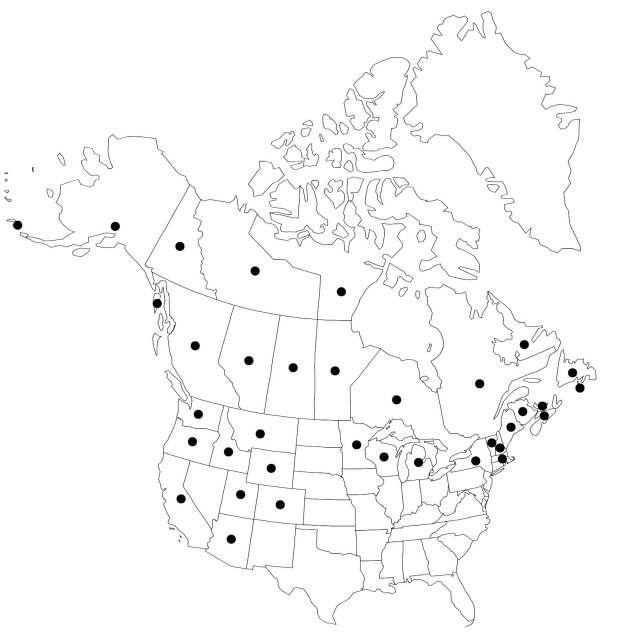Carex lenticularis
Fl. Bor.-Amer. 2: 172. 1803.
Plants cespitose. Culms obtusely angled, glabrous. Leaves: basal sheaths brown; sheaths of proximal leaves glabrous, fronts lacking spots and veins, entire, apex truncate, somewhat prolonged; blades amphistomic, papillose on both surfaces. Proximal bract longer than inflorescence. Spikes erect; proximal 3–4 spikes pistillate, base cuneate or attenuate; terminal 1 spike staminate. Pistillate scales pale-brown or black, shorter than perigynia, apex obtuse, awnless. Perigynia ascending, green, veined, tightly enclosing achenes, thin-walled, ellipsoid or ovoid, dull, base truncate, distended, apex acute, glabrous. Achenes not constricted, glaucous.
Distribution

Alta., B.C., Man., N.B., N.S., N.W.T., Ont., P.E.I., Que., Sask., Yukon, Alaska, Ariz., Calif., Colo., Idaho, Maine, Mass., Mich., Minn., Mont., N.H., N.Y., Oreg., Utah, Vt., Wash., Wis., Wyo.
Discussion
Varieties 5 (5 in the flora).
Carex lenticularis is distinctive in vegetative and reproductive characters. Plants are slender, light yellow-green, cespitose, with pale brown basal sheaths and proximal sheaths. The inflorescence bract is longer than the inflorescence, which has a single staminate spike or, in arctic or alpine taxa, a gynecandrous terminal spike. Proximal spikes are not staminate at the apex, unlike other members of sect. Phacocystis in which the proximal spikes may have staminate flowers at the apex. Perigynia are veined, distended at the base by the achenes, white on the proximal half, and stipitate. The amphistomic leaves and high chromosome numbers also distinguish the species, which includes five, usually allopatric, varieties in North America that may be difficult to separate in areas where their ranges overlap. Very closely related species, which may be conspecific, are C. rufina and C. eleusinoides in North America and C. hermannii in Central America. The South American-Australasian C. decidua is also very similar to the complex.
Selected References
None.
Lower Taxa
Key
| 1 | Terminal spike gynecandrous; proximal spike not exceeding 1.5 cm; peduncle less than 1 cm; perigynia ovoid. | Carex lenticularis var. dolia |
| 1 | Terminal spike usually staminate; proximal spike longer than 1.5 cm; peduncle 1 cm or longer; perigynia ovoid to ellipsoid. | > 2 |
| 2 | Pistillate scales pale red-brown; beak of perigynium green; proximal bract white at base; stipe 0.1–0.25 mm. | Carex lenticularis var. lenticularis |
| 2 | Pistillate scales dark purple-brown or black; beak of perigynium purple-brown; proximal bract red-brown at base; stipe 0.1–0.7 mm. | > 3 |
| 3 | Proximal spike 4–6 mm wide; stipe of perigynium 0.4–0.7 mm. | Carex lenticularis var. limnophila |
| 3 | Proximal spike 3–4 mm wide; stipe of perigynium 0.1–0.4 mm. | > 4 |
| 4 | Perigynia spotted purple-brown on apical 1/2, 1–3-veined on abaxial face; beak entirely purple-brown. | Carex lenticularis var. impressa |
| 4 | Perigynia not spotted purple-brown, 5–7-veined on each face; beak purple-brown at apex only. | > 5 |
| 5 | Stipe of perigynium 0.2–0.5 mm; beak 0.1–0.5 mm; w North America. | Carex lenticularis var. lipocarpa |
| 5 | Stipe of perigynium 0.1–0.15 mm; beak 0.1–0.2 mm; e North America. | Carex lenticularis var. lenticularis |
"shortened" is not a number.